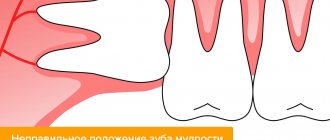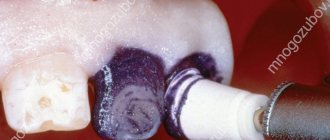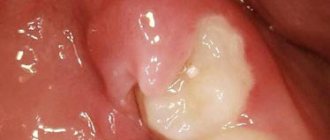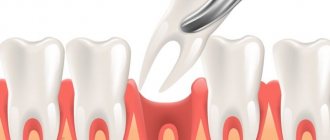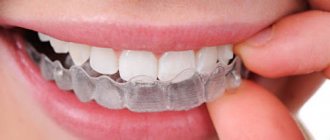Wisdom teeth erupt much later than others (at 18-30 years), which is why they got their name. Due to their location, they are also called “eights” and third molars.
Wisdom teeth are designed for chewing food, but most often they do not perform their functions. They do not have milk precursors, which makes their eruption difficult. In addition, with age, tissues become denser. As a result, the appearance of third molars leads to various problems: displacement, immersion, damage to nearby teeth, inflammatory processes, the development of caries, and malocclusion. Quite often, the tooth fails to erupt and remains under the gum. In this case, a “hood” forms over it, which becomes inflamed and creates conditions for the development of pathogenic bacteria.
Indications for removal of the “eight”
When the third molar is affected by caries or becomes the cause of pain, the help of a dentist will be needed. But what to do in such cases: remove or treat the damaged tooth? The answer to the question depends on the specific situation.
It is necessary to remove a wisdom tooth if it:
- incorrectly located in the dentition;
- deforms the jaw;
- disrupts the bite;
- does not have enough space for teething;
- severely destroyed and cannot be restored;
- susceptible to the development of periodontitis, osteomyelitis, cysts, inflammation of the trigeminal nerve;
- interferes with nearby teeth;
- injures gums and cheeks.
How many teeth can be removed in one visit?
Most often, the surgeon removes only one diseased tooth at a time. The patient will have an appointment 1-2 weeks later to have the other units removed. This is necessary so that the wound has time to heal and does not bleed. Sometimes, for example, when the affected teeth are located nearby, they can be removed at the same time. The reason for this is the local action of the anesthetic.
Due to the fact that extraction is a very traumatic process, multiple operations are highly undesirable. As a result of such a serious intervention, a wound that is too large may form, which will heal over a long period of time and cause a lot of trouble for the patient.
However, in children, tooth extraction takes place with less effort, so the resulting hole heals much faster. This makes the dentist’s task easier, since in one visit he can pull out 2 or 3 temporary teeth at once. Of course, a lot will depend on the baby’s well-being and behavior; he must be diligent and patient.
Reasons for difficult removal
Removing wisdom teeth is significantly more difficult than removing other teeth.
This situation is due to many factors:
- distant and non-standard placement of “eights”, which makes them difficult to access for surgical interventions;
- abnormal development or inability to erupt;
- a large number of deeply located and branched roots.
The complexity of the operation is significantly influenced by the location of the third molars. The lower jaw is wider and denser than the upper, which allows the roots to branch greatly and penetrate much deeper. Therefore, removing a lower wisdom tooth is much more difficult than removing an upper one.
In some cases, difficult removal of a wisdom tooth in the lower jaw can cause suppuration of the socket, which can lead to abscess, sepsis, lymphadenitis, phlegmon, and osteomyelitis. Therefore, if pus is detected, you must immediately contact your dentist.
The upper jaw is narrower and looser, as it has many holes. Therefore, in most cases, removing the upper wisdom tooth is not difficult for the surgeon. In addition, the upper jaw is easier to anesthetize.
Removing a wisdom tooth in the upper jaw becomes more difficult if the “eight” is severely damaged or has curved roots.
What problems may arise
- almost 80% of cases
, the eruption of third molars is accompanied by various purulent-inflammatory processes.
A mucous hood
is formed over the erupting unit , a pocket is created around it, where bacterial plaque and food debris accumulate, which leads to purulent inflammation -
pericoronitis
. - Often, figure eights grow towards the tongue, cheek, palate, constantly injuring the mucous membrane, causing a lot of painful and uncomfortable sensations. Chronic injury to soft tissues
can lead to the formation of ulcers, erosions, and the development of leukoplakia (hyperkeratosis) - the mucous membrane in the injured area becomes denser. If the cause (traumatic tooth) is not eliminated, there is a risk of neoplasm (including malignant). - Between 8 and 7 (on contact surfaces) a carious cavity is formed
where food is constantly clogged, contributing to the rapid development of caries. The carious process affects not only the number eight, but also the 7th molar, which is important for the dental apparatus. In case of interdental caries, it is necessary to remove the wisdom tooth and properly treat the seventh molar. - Sometimes the figure eight, positioned horizontally in the gum, rests on the root of a neighboring tooth, injuring it, causing the formation of a cyst
. In the worst case scenario, such a pathology can even lead to resection of the jaw bone. As a result of a long asymptomatic period, cysts can acquire significant sizes and damage the surrounding bone tissue and neighboring units. - Wisdom teeth can put serious pressure on adjacent units, moving them out of place. This pressure is transmitted to all teeth, causing row deformations
, malocclusion, and periodontal disease.
Types of deletion
Removing a wisdom tooth in dentistry can be simple or complex.
With simple removal, forceps or an elevator are enough, there is no need to cut the gum and drill the bone. The doctor attaches forceps to the dental crown and loosens the tooth to remove it from the gums. After tooth extraction, the wound is washed with an antiseptic solution.
In this case, the procedure minimally injures the oral cavity, the pain syndrome does not bother the patient much, and the hole heals quickly.
Complex removal will require preliminary preparation. In this case, the volume of bone tissue is reduced, part of the gum is excised, or the roots are separated. For these procedures you will need a drill and additional surgical instruments.
Does it hurt to remove?
A typical mistake made by patients before tooth extraction is the desire to start the procedure faster in order to “get over it” faster. In this case, the anesthesia does not have time to completely dissipate through the tissues and the patient will face a painful procedure. Therefore, you need to wait a certain time, which is suggested by the dentist.
Stress factors can also affect pain during surgery. During the effect of anesthesia, you need to remain as calm as possible, which will allow you to carry out the procedure quickly and with the least risk.
How is tooth extraction performed?
Before you begin wisdom tooth removal in Moscow, you will need to take an x-ray. It will show the location of the molar, the degree of eruption, the number of roots, the direction of their growth and branching characteristics, which will facilitate the dentist’s work and help avoid complications. The doctor will also find out whether the patient has any contraindications to surgery.
After receiving the necessary information, the dentist treats the tooth and nearby tissues with an antiseptic, then administers anesthesia and begins to remove the tooth.
At the end of the procedure, the hole is cleaned of residual dental tissue and other “dirt”, and then washed with an antiseptic solution. Anti-inflammatory drugs are used if necessary. In case of difficult removal, sutures must be placed on the gums.
If the molar is impacted (cannot erupt), the wisdom tooth hood will need to be removed. In this case, a good surgeon will cut the gum and remove the bone tissue in parts.
If you are interested in how long the procedure for removing the figure eight takes, then you should know that the duration of the operation depends on its complexity. For simple removal, 5-15 minutes are enough, and for complex removal it will take from 20 minutes to 3 hours.
Quite often, patients are concerned with the questions: “Does it hurt to remove a tooth?” and “How long will your gums hurt?” Usually the removal process is not accompanied by pain, as modern effective painkillers are used. The pain begins to worry after removal, when the medicine stops working. Its duration and severity depend on the complexity of the operation and the individual sensitivity of the patient.
The next question the dentist is asked is: “How much does it cost to remove a wisdom tooth?” It is impossible to answer it unequivocally. The cost of wisdom tooth removal in Moscow depends on many factors: the clinic, the professionalism of the staff, the complexity of the operation.
The price is determined by the cost of anesthesia, x-rays, additional medications and the specifics of the removal procedure. It is influenced by the location and condition of the tooth, proximity to the nerves.
What do we have to do
After the removal procedure, you need to limit your activity for a while, adhere to a healthy lifestyle and diet.
It is better to take the so-called “sick leave” - spend time at home in a calm environment, closely monitoring your condition.
Smoking and drinking alcoholic beverages are prohibited; it is better to abstain from them.
The menu for the recovery period should consist of nutritious food that does not require thorough chewing. It is better to reduce the number of meals by increasing the calorie content of dishes.
It is imperative to carry out hygienic procedures, since ignoring them can trigger an inflammatory process in the socket of an extracted tooth.
Mouth rinsing is prohibited; it is better to replace it with medicinal baths.
You need to make sure that the postoperative sutures do not come apart; to do this, you should not open your mouth wide or strain your facial muscles.
How to speed up healing?
At the end of the operation, the doctor will give recommendations after removal:
- hold a gauze pad with your teeth for 20 minutes to stop bleeding;
- refrain from eating for 2-3 hours;
- until the wound heals, avoid cold and hot foods;
- do not chew on the side where the tooth was removed for at least 3 days;
- do not touch the hole with anything;
- do not brush your teeth for 24 hours;
- every other day, rinse the mouth with antiseptic agents, and in some cases with antibacterial drugs (in the first 24 hours, rinsing is contraindicated; medicinal baths can be used);
- Avoid laughing and opening your mouth wide to prevent sutures from coming apart.
In the first hours after removal, you can apply cold, but not heat, to your cheek. Warming up can provoke purulent inflammation!
How long does it take for a hole to heal? This process is quite lengthy and takes from 3 to 5 weeks. A blood clot formed in the socket will help speed up the process. Therefore, doctors do not recommend rinsing immediately after tooth extraction.
We remove the problem, not the tooth
Very common problems are cysts or granulomas. They are a type of tumor that not only can be a source of pain, but also destroy bone tissue. Cysts become especially painful during a cold or after experiencing stress. It is then that the problem appears in all its glory on the X-ray.
The cause of the appearance of a cyst or granuloma can be an infection in the gum, most often due to careless tooth filling. The consequences of an untreated cyst can be anything. Since it is a source of infection, there is a high risk of infection entering the blood and spreading throughout the body. Such disorders are neurological in nature. Peri-, myo- and endocarditis may occur. Another common consequence is rheumatism of the joints. preventive cleaning and treatment should not be neglected
Previously, in order to clean out the cyst bubble, the tooth was actually removed. This makes it much easier to treat the gums and control the further course of the disease, but now, basically, three other, more progressive methods are offered.
- Cystectomy. During this procedure, the doctor cuts out the cyst and the damaged part of the root. The resulting hole is cleaned and filled with special medications, which should promote the growth of new bone tissue. If everything goes according to plan, the hole will heal and infection will no longer accumulate in it. Full recovery usually takes at least three weeks.
- Hemisection. If one of the tooth roots can no longer be saved, it is removed along with the cyst. After this, the hole is cleaned, treated with disinfectants and closed with a crown. This manipulation is simpler, so the functionality of the tooth is restored faster.
- Laser dialysis. This procedure is not carried out in all clinics, but it is quite effective. The cyst is “killed” using a laser beam that is injected directly into it. This also disinfects the root itself, eliminating the need for additional procedures.
If the granuloma is small, you can try the same tooth depophoresis . In 2-3 procedures you can defeat the infection at the root. It will be practically painless, but you need to strictly follow the procedure and properly care for your oral cavity between them.
Is general anesthesia necessary for tooth extraction?
In most cases, local anesthesia is used for tooth extraction, but sometimes the doctor may recommend general anesthesia, which:
- completely relieve pain;
- will help avoid panic fear;
- will facilitate complex operations;
- will prevent accidental injuries.
Wisdom tooth removal under general anesthesia is carried out only in some clinics.
But don’t rush to look for where to have your wisdom tooth removed in Moscow under anesthesia. First, check if you have any contraindications to this procedure:
- individual intolerance to anesthetics;
- cardiovascular pathologies.
When and why is it prohibited to remove more than one tooth?
The procedure will not be performed in cases where the teeth to be removed are on opposite sides of the jaw. It is recommended that they be removed in two visits so that the patient can chew food on one side while the wound on the opposite side heals. It is not recommended to remove several teeth on one side of the jaw, because a large free surface leads to excessive mobility of neighboring teeth. This often occurs when there is potential for significant damage to the gum margin, bone, and excessive blood loss. Multiple extractions often cause swelling and characteristic pain. Occasionally, sutures are placed on the postoperative area. The doctor will strictly prohibit the removal of several teeth at a time if the patient has been diagnosed with: diseases of the cardiovascular system, low blood clotting, high blood pressure. This is because extraction in such cases puts stress on the body. There is also a risk of an allergic reaction to the anesthetic. A person is afraid of feeling severe pain during surgery - this also serves as a very significant factor in the ban on multiple removals. In addition, this type of operation is accompanied by a long rehabilitation period, which for the patient is an additional reason for the ban.
Treatment of complications with the growth of figure eights
The most common complication with the growth of figure eights is pericoronitis
(formation of a gum hood). When a molar erupts, it is forced to overcome many obstacles: the jaw bone, periosteum, and periodontal tissue. During long, complex eruption, a specific mucous canopy (hood) is formed over the molar. Bacteria and food particles penetrate under it, which causes inflammation.
If coronary artery disease is not treated, the consequences will be serious, the inflammation will spread to the periosteum and jaw bone. This is fraught with the development of periostitis, osteomyelitis, tissue suppuration with the formation of phlegmon, cysts, and fistula tracts. Nearby tissues may be affected, and inflammatory ENT pathologies (otitis media, sinusitis) may occur.
Treatment of pericoronitis is surgical and involves excision of the mucous hood. The operation opens access to the growing eight. The doctor removes the affected tissue, carefully treats the surgical area, and evaluates the clinical picture. According to the situation, he decides whether to remove the eights or help the molar to erupt completely, taking the correct place in the row.

